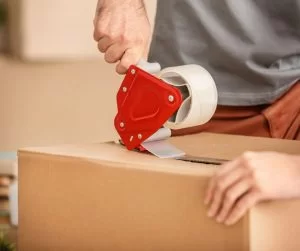Moving your entire library to a new home is exciting, but it can also be daunting. Bookshelves, boxes, and the weight of your books themselves can combine to form a heavy load to carry, and transporting large quantities of books can be tricky. But the books that you’ve collected painstakingly over the years need some love and patience to get them packed safely.
So follow these do’s and don’ts to the T when packing books for the move so that you don’t damage them and get them delivered safely.
Do’s When Packing Books for Your Move
-
Do Plan Ahead

The key to a successful move is organization and an efficient packing plan can help keep things moving smoothly. Pick up each book one at a time and decide whether it needs to be packed immediately or stored in boxes later. This can also help you figure out if you need enough storage for everything or whether you need to set some books aside for storage.
-
Do Pack Them Carefully
Books are heavy and many people underestimate how much weight they actually add to their moving truck. So make sure to plan and pack the books based on the weight. If you don’t pack them well, you might find yourself scrambling to collect all the books as the box bursts open under the heavyweight.
-
Do Use Special Boxes

If you’re using cardboard boxes, sturdiness is key. You’ll want to use boxes that have reinforced sides and bottoms, like those made from corrugated materials rather than plain cardboard.
Although you can pack books in regular moving boxes, it is better to use smaller ones designed for this purpose. They are sturdy and have compartments that make it easier to keep your book collection organized and protected while they’re being moved.
-
Do Use a Protective Wrap
When you pack books for moving, use protective wraps around volumes that have particularly high values or are of particular sentimental value. This is an effective way to prevent the covers from getting damaged in transit and prevent any damage from exposure to moisture.
-
Do Cut Out Extra Space
Books are heavy, so the more space they have inside a box, the more likely they will get damaged. If your book has a dust jacket, remove it before packing — this will increase safety and give you more room in the box.
-
Do Use Bookends
Bookends are a great way to protect valuable volumes and keep them in good condition during transit. When you’re packing books for your move, you run the risk of damaging their bindings when you stack them as such. Bookends solve this problem by preventing the volumes from being stacked on top of each other and thus preventing their bindings from being damaged in any way.
-
Do Tape the Spine
The easiest way to protect the binding of hardcover books is by taping the area where the pages and cover come together. Don’t wrap the whole book with tape, but instead place strips of tape on the exposed spine. This will support the pages as they travel through transit and prevent them from becoming damaged or even falling out of their binding.
Don’ts When Packing Books for Your Move
-
Don’t Stack Them
Do not pack your books right on top of each other, but stagger them, so they don’t get stuck together. Stacking your books on top of each other can result in damaged spines and broken pages. Make sure that the boxes containing your books are strong enough to hold them well and prevent them from moving around too much during transport
-
Don’t Pack the Books with Other Items
Do not pack your books in boxes that have other types of items. Books are the most delicate items in a household when it comes to packing. The box’s contents can shift, or the box may be dropped, causing damage to the books. Use book boxes or paper and tape to wrap them securely in place.
-
Don’t Stack the Big Books on the Top
While packing books for moving, always stack smaller-sized books on top and make sure that they are firmly stacked using bubble wraps or bookends. This will help prevent them from falling if the box gets tilted during transit.
-
Don’t Keep Them in Storage
Do not put your books in storage boxes or bins destined for storage. They will likely be stacked on top of each other, which could cause damage. If you need to store them anyway, wrap them securely in paper and place them in strong plastic bins to prevent dust from getting on your books.
-
Don’t Stuff Packing Peanuts
Do not use a lot of packing peanuts to cushion your books. They will absorb moisture and get moldy, which can cause book pages to stick together or smell bad.
Final Thoughts
Moving is usually a stressful time and when your valuable books are involved, the stress can go through the roof. If you want to protect the books that you’ve collected so dearly, you can get the help of professional movers.
At Yes Movers, we have a team of experienced removalists who have helped hundreds of people to relocate their books as well as their belongings safely. Call us at 0434 379 742 or email us at info@yesmovers.com.au to get more details on how we can help you pack your books.

 0434 379 742
0434 379 742







